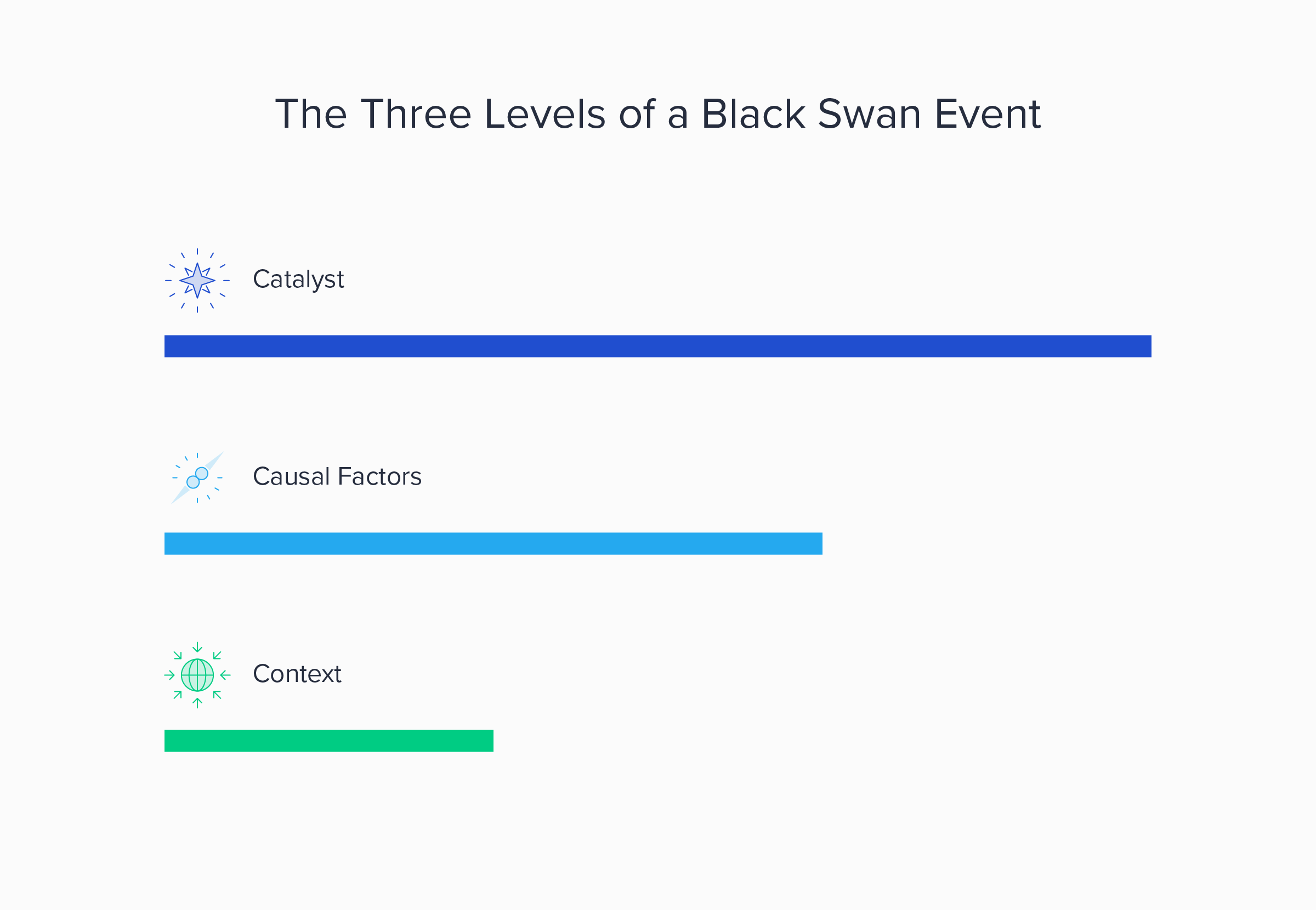COVID-19 Lessons: Organizational Adaptability, Going Remote, and Black Swans
authors are vetted experts in their fields and write on topics in which they are extremely knowledgeable. All of our content is peer reviewed and validated by world-class professionals.

Read the other installments in this series:
- Black Swans and the Paradigm Shift of Remote Work – COVID-19 Lessons, Part 2
- Black Swans 3: How Challenges Lead to Breakthroughs
The tragedy of COVID-19 and its dislocating effects on global supply chains has demonstrated our ongoing exposure to rare, high-impact “black swan” events. The upside is that COVID-19 offers critical teachings for the next disruptive event—whether a natural disaster, a geopolitical conflict, or of a nature unforeseen. We can’t predict the next emergency but we don’t have to. We live in an emergency-prone world and can proactively prepare for disruptions to our work, so that adaptability takes the place of knee-jerk reactions—reactions that can backfire and compound situations rather than contain them. We should react to emergency situations with all due haste, of course, but COVID-19 presents an opportunity to reflect on how to position our businesses for more seamless and positive responses.
After having the extraordinary good fortune of learning from Nassim Taleb during my formative years, I dedicated my professional life to helping organizations understand and confront black swan events. I focused on crises in global financial markets and then a more positive breed of black swan in the form of global startups and global technological innovation. I witnessed certain lessons through these different situations in terms of how we can better prepare ourselves for such events.
While I hope organizations now forced to experiment with virtual work end up discovering its many benefits, I also worry that doing so under such circumstances risks chaotic and subpar results, tainting their view of remote work. This unfortunate and preventable situation may haunt these organizations well beyond the point at which the virus is contained. Remote work must be approached as a proactive means of preparing an organization for inevitable changes ranging from technology to global emergencies, not as a reactive measure once such events have already happened.
This article focuses on three points:
- How black swan events generally come to pass in the first place and how this makes them so impactful and difficult to predict.
- How certain standard business practices exacerbate this process.
- How we can proactively create more organizational adaptability when such events do occur and why this is even more important than providing downside protection (i.e., insurance policies).

How Black Swans Are Born
There are three general levels in which these rare, high-impact events need to be considered, and unfortunately, we tend to focus on the wrong one when attempting to understand them. We make this mistake both when they transpire and as we try to predict the next one. These three levels are:
Context. No seismic event occurs in isolation. The difference between a merely dramatic event and a real black swan comes down to whether there is a new overarching context in the global economy that sets the stage for a specific incident to escalate.
Causal factors. Note the plural. A true black swan almost invariably results from the collision of multiple interconnected causes that build upon each other once set in motion, which is what makes them so difficult to anticipate and understand.
Catalyst. This is the spark that sets all the rest in motion and can take any number of forms. If the context and causal factors are in place, then a catalyst will eventually transpire, and its specific form does not matter. COVID-19 is becoming a black swan in itself but is also threatening to serve as the catalyst for subsequent black swans. It is causing financial market and fundamental economic dislocations, and the extent to which these effects transpire will depend on whether we react with flexibility and perspective or panic.
One of the biggest saboteurs of our attempts to understand these events is our tendency to confuse the catalyst—the most immediately obvious factor—with the real underlying causes or even the context. Too often, we attempt to predict and manage catalysts rather than understand what allowed them to ignite such dramatic events in the first place. We lament how any specific emergency was impossible to foresee, but predicting a specific event neither can nor should be the point. We can instead study the underlying context and potential causal factors that expose us to certain types of risk, and it’s our responsibility to proactively prepare. We have had epidemics before and should understand that our increasingly interconnected world makes the risk of another outbreak very real.
Similarly, we can rarely predict when the next disruptive technology will transform an industry, but we clearly live in a world where such events transpire and can identify certain contexts and emerging casual factors that make specific industries more likely to experience them. It’s telling that we use the terminology of viruses when discussing technology—“virality” and “viral loops,” for example, as both abide by the dynamics of rapid, exponential growth. (Like contracting a virus, when a group adopts a new technology it makes those around them more likely to do so as well.) When building my own venture fund, my go-to metaphor for proactively embracing technology—even if you did not consider your company to be “in tech”—was that of vaccinations: the need to inject a certain amount of it into their system in order to be ready for transformative events.
None of this is meant to imply that we should live in paranoia. This viewpoint is instead meant to liberate us from living in fear and feeling helpless against uncertainty by emphasizing our power to proactively understand what types of events we are exposed to, how to sense when this exposure is increasing, and how to prepare ourselves with proactive flexibility instead of fire drill-style emergency measures.
We now turn to specific business practices that can contribute to or help limit our exposure to such events.
How to Better Prepare
With the more general dynamics of these events in mind, we now turn to how our behaviors can better strengthen our systems to not only survive but continue to thrive when they occur.
Continue to Implement a Degree of Remote Work
Even if you do not foresee a large-scale remote work program for your company once the current crisis has abated, continuing with a limited one will bring unexpected benefits in terms of productivity and flexibility for smaller-scale emergencies. It will also further familiarize you with the best tools and processes if you do decide (or are compelled by circumstance) to ramp it up again. This allows you the freedom to experiment and learn by trial and error before the matter becomes urgent. Begin using Slack for communication and virtual conferencing platforms such as Zoom in place of certain in-person meetings and consider declaring Fridays or other times as remote days.
I have found that the supposed “limitation” of remote work—not sitting physically next to my team members—translates into an advantage. Communication and collaboration are far more focused, purposeful, and results-driven versus most traditional office settings. As tragic as these crises are, do not accept them merely as crises to survive but as opportunities to discover new and better ways to work and position ourselves within our value chains.
This is the vaccination metaphor that I’d previously used for technology—inject a bit of it into your system now so that you’re ready just in case. You’ll find productivity benefits to a more flexible and modernized workplace quickly and will have taken the first step toward a far more flexible and adaptive way of working. While we can never know what the next emergency that necessitates remote work might be, it would be dangerous to deny that such events will continue to inspire. Speaking of which...

Focus on Scenarios Over Prediction
It is a cruel twist that the events we collectively agree are least likely to transpire will become more likely to do so. If you believe you have an iron grip on a certain market, for example, then you will become increasingly complacent and invite more competition. While we need not cease to predict entirely, we do need to adopt a mindset far more concerned with what scenarios can happen, rather than what we view (or hope) as most likely to happen. Do not try to eliminate risk. Eliminating risk is akin to holding down the lid on a boiling kettle—things will appear stable for a while and then blow up.
When building financial operating models, I always include a “Stretch” scenario (startups should, of course, reach for the stars), a “Baseline” scenario (successful but more moderate assumptions), and a “Survival” scenario. These scenarios do not simply differ in top-line results but include different evolutions in operations and cost structure based on specific real-world narratives and what-ifs. Sometimes, there are multiple “Survival” scenarios as we identify additional pockets of extreme risk. This exercise forces a review of the key events that could transpire and proactive preparation so that, at least, we never go below the “Survival” scenario.
The early fixation on the concept of equilibrium in economics was in many ways a tragic misdirection. It locked us into the dangerous pursuit of false stability, rather than respecting the competitive advantage of an ongoing dynamic process. We mistakenly look at momentary equilibrium and forget how it’s a component of a larger process of transition—the equivalent of taking a photograph of a wave and assuming that, since the photograph itself is static, we’re looking at a stable mountain. Equilibrium is a moving target and—even when things seem to be going perfectly—must be respected as such.
The Next Black Swan is Often Born Out of Our Reaction to the Prior One
To get the most direct sense of your vulnerabilities to the next crisis, take a hard look at how you reacted to the prior one and what rules you implemented. We all have a bad habit of short-term overreaction, which then sends us too far in the opposite direction and exposes us to new mistakes.
While the sun is shining, rigorously review the decisions made in the aftermath of your prior crisis. With the clarity and cooling of emotions afforded by time, you may identify vulnerabilities or imbalances that you unwittingly put into your value chain. This does not mean softening or forgetting the lessons of the past. Many of the measures were implemented for very good reasons. It is likely, however, that, in doing so, you went too far in certain opposite directions making yourself vulnerable on a different flank. Look out for always, never, and other absolute terms that crept into your subsequent rules of engagement. The world is far more complex than this, and these decisions may have exposed you to new imbalances.
History is full of examples of how reactions to prior black swans contribute toward subsequent ones. After the First World War, we resolved to never go to war again since the prior one was so pointless. We resolved to always play strong defense should another conflict arise, since offense was so costly due to WWI’s more static technologies. These absolutist beliefs tragically led us to do the exact opposite of what we should have when the next conflict came about.
Without forgetting the core lessons of that conflict, a review of these decisions as circumstances changed could have limited the scale of the next one. This re-review of the reactions and decisions to prior crises can benefit tremendously from bringing in additional outside expertise. These exercises are effectively stress tests and audits. The whole point is to raise questions that may have been previously overlooked and consider previously instilled assumptions and rules with fresh thinking.
History is not a series of casual events; it is, unfortunately, often a series of short-term overreactions and long-term underreactions. We have all been guilty of this kind of absolutist and reactionary decision-making and have a duty to review our prior major decisions as context and potential causal factors continue to evolve around us.
Those who are prepared may well end up consolidating market shares from those who were not, especially if pent-up demand is unleashed once the event subsides. If you have reason to believe that customers have merely delayed a significant portion of their purchases rather than canceled them outright, then the subsequent rebound is exactly the moment you do not want to be caught with diminished and inflexible capacity.
Why This Is Important
In a system defined by complexity and/or change, efficient and optimal are very different things. If you are driving down a stretch of highway that you know will be straight and narrow, by all means, bring your speed up to optimal miles per gallon. If you’re on a road with sudden and dramatic turns, this approach becomes far less advisable.
Every crisis is an opportunity because it allows us to review our foundational assumptions and make necessary adjustments. This opportunity is a terrible thing to waste. Instilling this organizational adaptability is not only important for surviving, it can also become an important competitive advantage allowing you to continue functioning at full speed while your competitors slow down or even come to a halt. It is too early to know the scale of tragedy COVID-19 will bring, but the calamity may catalyze a surprising upshot: renewed appreciation for flexibility and proactive preparation in how we work and make our most impactful decisions.
Read Part 2 in this series: Black Swans and the Paradigm Shift of Remote Work
